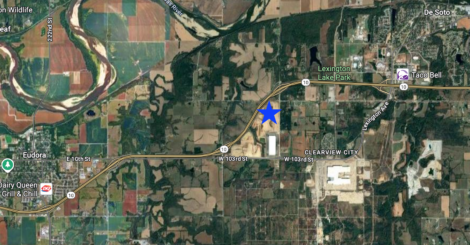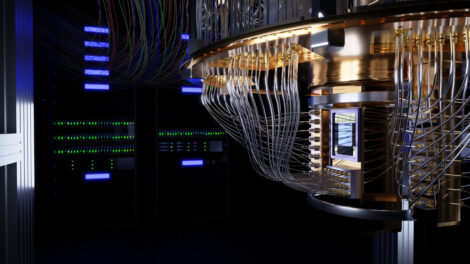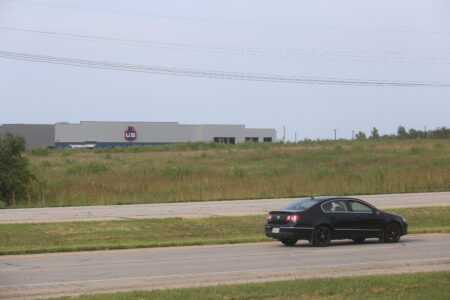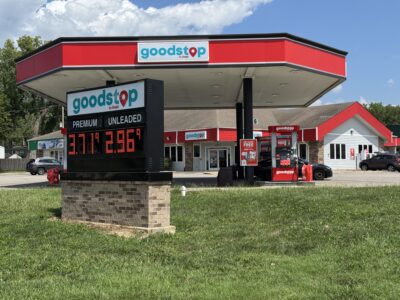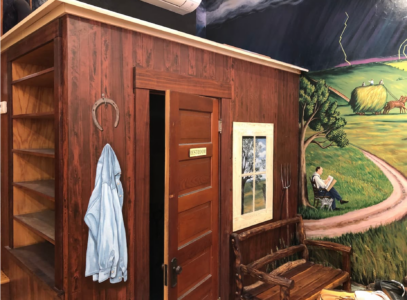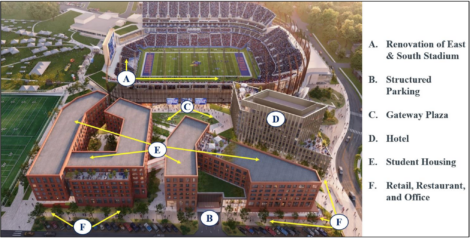
Panasonic says it will take two years to get to 4,000-employee mark; it expects about 90% to come from KC metro area

photo by: Chad Lawhorn/Journal-World
The Panasonic battery plant in De Soto is shown on June 20, 2024, as about 2,000 construction workers continue to build the nearly 5 million square foot facility.
A surge is coming.
Within a few weeks, electric lines leading into the $4 billion Panasonic electric vehicle battery factory in De Soto will be hot with up to 290 megawatts of electricity. The employment lines at the plant — just about 20 minutes from eastern Lawrence — will be full, with the plant hiring at least 100 new employees per month for the foreseeable future. And the biggest surge will be at the end of the production line. When the plant is operating at full capacity, it will produce 66 batteries per second.
Here’s one surge, though, not to expect, at least not soon: Lots and lots of new Panasonic workers moving to the area.
While the plant is scheduled to start producing batteries in the first quarter of 2025, Panasonic officials at a media event on Thursday said it could be another two years before the plant reaches its projected employment total of 4,000 people. A Panasonic leader also confirmed that the company expects the vast majority of new hires to be people who already live within a 45-minute drive of the plant in De Soto.
That may mean that Douglas County communities like Lawrence or Eudora — a 6,000-population town just 10 minutes from the plant — won’t see a boom in residential demand in the near term.
“I love the De Soto area and Eudora area myself,” Kristen Walters, vice president of human resources for the Panasonic plant, said. “Will some people choose to locate a little farther this way? Maybe. Will that be immediately? Probably not. I agree that it probably will be that 80% or 90% of the team members will come from the Kansas City metro area.”
That’s a different scenario than what has happened with Panasonic’s other large, U.S. electric vehicle battery plant near Reno, Nevada. That area has nearly doubled in size in the last decade, said Allan Swan, president of Panasonic Energy of North America.
“But that was a whole different thing that Reno was trying to do otherwise,” said Swan, who noted that there have been many growth drivers other than Panasonic in the Reno area.
The biggest difference between the Reno and De Soto areas is population. Swan said the De Soto plant has more than 1 million people within a 45-minute drive of the plant. That 45-minute population is three to four times larger than what exists in the Reno area.
“That is one of the reasons we chose to be here, honestly,” Swan said.

photo by: Chad Lawhorn/Journal-World
A Panasonic-produced slide shows an aerial view of the under-construction battery plant in De Soto.
Swan said with a million-plus people within an easy drive of the plant, Panasonic is counting on being able to attract employees — especially production workers — without having to import many people from outside the region.
That doesn’t mean communities like Eudora and Lawrence won’t see residential and commercial growth tied to the plant. As Walters noted, it is likely that some employees at the plant who are driving from the outer edge of the KC metro area may decide they want to live closer to their work, which may benefit Eudora, and to some degree, Lawrence. But those residents may not be considering that type of move on day No. 1.
The other wild card is how many suppliers for the Panasonic plant will choose to locate branches or offices near the De Soto facility. State officials, who have supported the Panasonic plant with historically large tax breaks, have estimated another 4,000 jobs could be created by third parties serving Panasonic.
On Thursday, Panasonic officials said estimating how many local jobs may be created by suppliers is difficult. Part of the difficulty is defining what you mean by a supplier. There are several companies that are direct suppliers of the plant, providing key raw materials and other such items. Panasonic said it is placing an emphasis on having as many American and Canadian suppliers as possible for the plant, though that doesn’t necessarily mean they would need to be located in the area around the plant.

photo by: Chad Lawhorn/Journal-World
Panasonic officials said they have no plans to demolish the row of water towers at De Soto site. The water towers are a remnant from when the site was home to the Sunflower Army Ammunition Plant. However, Panasonic said only one of the four towers is functional. Panasonic officials said they recognized the towers were a distinctive part of the area’s skyline, though they said they may paint the towers.
Swan, though, said what has happened in Reno has been instructive. He said all sorts of small businesses that provide services but not necessarily materials to the plant have emerged in those Nevada communities. Swan mentioned companies such as small engineering firms, tooling companies and fixture businesses as examples of the types of service-providing companies that likely would be near the plant.
At the Reno plant, Swan said studies have shown that for every one job that exists in the Panasonic plant, there are three jobs outside the plant that are somehow tied to the plant’s work. If that number held true at the De Soto plant, that could be more than 10,000 outside jobs. Swan said the Nevada results may not fully translate to De Soto because the Nevada plant is next door to a Tesla plant, which changes the numbers significantly.
Kansas officials have made no secret that they would like to attract an electric auto manufacturer to the site, which has hundreds and hundreds of acres available for development on land that previously was home to the massive Sunflower Army Ammunition Plant.
While the specific numbers aren’t yet known, what is clear is that the number of third-party jobs the plant produces could have major impacts on the need for commercial and residential space in De Soto and surrounding communities.
In other words, workers employed by Panasonic may not create quite the population surge once expected in area communities. But, will workers employed by businesses surrounding the plant do so? Like many issues surrounding the plant, answers aren’t yet known.

photo by: Chad Lawhorn/Journal-World
This Panasonic produced slide compares the size of the nearly 5 million square foot battery plant, shown in white, to several types of structures, including the Eiffel Tower, the Empire State Building, cruise ships, jetliners, a football fields and others.
Panasonic officials on Thursday did provide details on several aspects of the plant’s pending opening. Here’s a look at several:
• About 3,000 of the ultimate 4,000 jobs at the plant will be production floor workers. Those workers are expected to earn wages in the $20 per hour to mid-$30 per hour range, Walters, the HR executive, said.
• Officials confirmed that many of the positions will operate on a 12-hour-per-day work shift. Walters said such long shifts were needed in order to efficiently operate the plant on a 24-hour, seven-day-per-week schedule. Walters said Panasonic hadn’t yet decided other details on work shifts, such as whether employees would work three consecutive 12-hour days and then have four days off, or whether it would involve a different type of schedule.

photo by: Chad Lawhorn/Journal-World
Thousands of square feet of scaffolding line the the Panasonic battery plant building during this phase of construction. A single worker is shown traversing the stairs on June 20, 2024.
• The plant currently has about 150 employees hired, including all of its leadership team. By the beginning of the year, the plant expects to have 500 employees in place. Officials said Panasonic expects to hire about 100 to 200 employees per month for the foreseeable future, until it reaches its 4,000-employee goal in the next couple of years.
• Evergy has built a large electric infrastructure facility adjacent to the Panasonic plant. That substation can handle 290 megawatts of electricity. Panasonic currently is estimating its plant will require about 110 to 160 megawatts during normal operations.
• There are currently about 2,400 construction employees on site each day. Construction totals are expected to peak at about 2,800 per day in the coming months. Thus far the project has used 12,000 trucks of concrete, 85,000 tons of steel, and 5 million cubic yards of soil.

photo by: Chad Lawhorn/Journal-World photo
The Panasonic construction site in De Soto is full of vehicles, as more than 2,000 construction workers are on site most days.
• At a production rate of 66 batteries per second, the plant would produce enough batteries per year to support 400,000 to 500,000 electric vehicles. At full capacity, the De Soto plant will be the largest in the world. Panasonic officials said they remained convinced that electric vehicles will soar in numbers.
“Our mission really is electric vehicles for the masses,”said Innocent Chikunya, vice president of operations for the plant. “We want to make sure that everybody has an electric vehicle, just like the personal computer.”

photo by: Chad Lawhorn/Journal-World
This is a photo of a Panasonic produce rendering of the battery plant upon completion.


